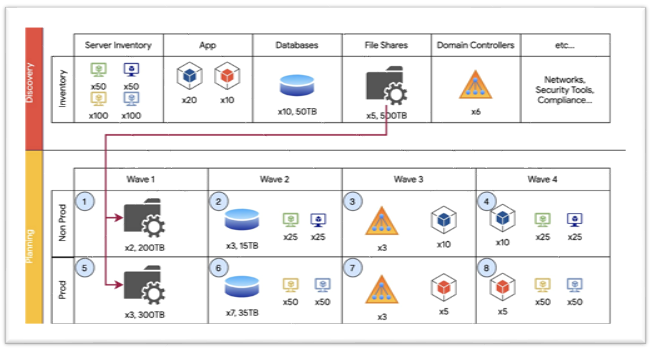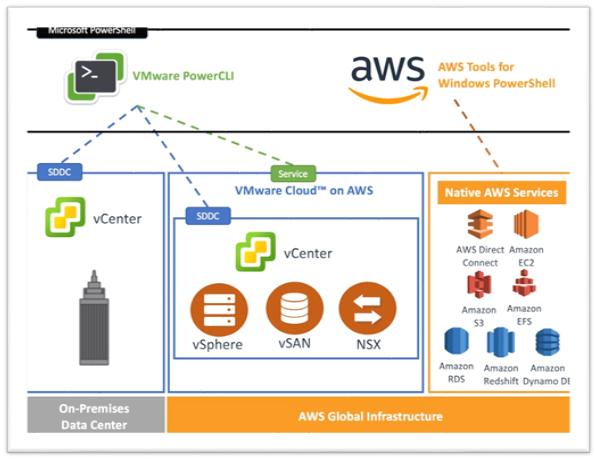 David Begic
VMware Practice Lead at Dicker Data
David Begic
VMware Practice Lead at Dicker Data
As IT leaders prepare to shift their workloads from our on-premises Datacenters into new Clouds (be it hosted Private Cloud, or Public Cloud), they know that time is usually of the essence. Whether it be a Datacenter lease agreement, or the end of life of aged infrastructure looming, or an excitement for change, the propensity to move as quickly as possible takes hold.
For some organisations, this process can take a lot of time. Months, even years to not only shift their workloads into Cloud, but to optimise and get the most out of their new environment. We’re seeing a dynamic shift to Web and Cloud-native applications, with a balanced approach to maintaining traditional applications and processes.
Cloud Migrations are typically phased out like so:
The assessment and planning stages are usually similar across organisations. Some of the following questions usually come up:
Where a lot of organisations differ is in the Execution and Optimisation phase. Some customers prefer to optimize (or transform) their workloads as they move into the Cloud. Transformation could be as simple as shifting a local Exchange resource to Office 365, or it could mean transforming an “old school” app into a shiny new web app.
Others will proceed with migrating everything as fast as possible and optimisation after this. There is no right or wrong way to do a Cloud migration, though one might argue that the longer a workload is left un-optimised in Cloud, the more costly it may be.

Once the discovery and planning phases are done – and really, these should be equally as long meticulous as the grunt work itself – it’s time to shift our applications and data.
There are different ways to get workloads into Cloud. The Public Cloud providers have their own toolsets that do much of the same as what we did to migrate physical servers to virtual “back in the day”. Equally, as most Private Cloud operators use the same technology and Hypervisors that we do, shifting workloads here are even more of a breeze.
The other way is by not migrating the applications at all, and rebuilding application servers and database systems and simply migrating the data. Again, there is no right and wrong way to migrate workloads, but how important is time and do you have it up your sleeve?
Here’s the clincher. Whether you migrate a workload as is into Azure or AWS as an IaaS (Infrastructure-As-a-Service) asset, or you rebuild that asset in one of these environments, you will need to have your IT staff ready. They will need to be skilled up and ready to deploy/manage these assets using native public cloud toolsets. Did you factor that in to the 4 phases of Cloud Migration? Think about it as step 0.5, or even 1.5.
Depending on the size and complexity of your environment, your workload types, and the diversity of your team, this upskilling could take months – even years. If your IT staff are used to delivering mission critical applications with virtual networking, and maybe some vSAN for good measure, on a vSphere platform today, they have built up that fundamental knowledge over time.
What if the knowledge could be used in the new world? What if the toolsets and knowledge that your team have built up over years can still be applied in Public Cloud tomorrow?
Without this sounding like a sales pitch, VMware is uniquely positioned to do two things in a Hybrid world:
Let’s talk about these two things in a little bit more detail. Azure VMware Solution, VMware on AWS, and Google Cloud VMware Engine allow customers to spin up a bare metal VMware solution, just as they would within their own Datacenter. The scope of migrating workloads now changes from rebuilding, refactoring, or reimaging and finger crossing, to a true lift and shift into a like-for-like environment. Customers with internal IT shops who know and use the VMware toolsets, leverage VMware’s scripting capability with PowerCLI, or spend their day in the vCenter console will continue to work just as they did in the past.
With all the virtual networking set up to a) facilitate the migration and b) ensure that systems are correctly communicating and accessible by users, the business can continue to run with minimal downtime. The best part about this solution is that customers can very well spin up a Multi-Cloud setup without worry of adding n layer of complexity, and have an elongated training and “honeymoon” process whenever they spin up a new Cloud instance.
What you effectively have is a bunch of Datacenters with infrastructure at your disposal, instead some of them are being managed and governed by Microsoft, some by AWS, and some by Google Cloud. Add to this the now extended capability of bolstering your VMware environment with Public Cloud (great SLA’s, Disaster Recovery on an as-needed basis, less operational overheads), and you have the best ingredients of “traditional” and “modern” to tackle tomorrow’s problems.

Finally, choosing a Cloud management solution is an important and complex task. Your business should depend upon technology that is supported amongst all major Hyperscale platforms. When choosing the right platform, ask yourself these questions:
Reach out to your Dicker Data VMware Pre-Sales team to further discuss this topic at further length, to workshop a real-life customer scenario, or to get an understanding how they may license VMware’s multi-cloud solutions to support you.
Contact sales@dickerdata.com.au for all your technology needs.

17 December, 2025 - 9 min read
As 2025 draws to a close, we’ve taken a moment to reflect on the... Read more

12 December, 2025 - 5 min read
We were thrilled to host the third edition of the Dicker Data... Read more

10 December, 2025 - 2 min read
In today’s fast-paced, AI-driven world, your customer's... Read more
Subscribe to the Dicker Data blog
for regular updates and insights

Dicker Data (ASX: DDR) is an Australian owned and operated, ASX listed hardware distributor with over 46 years experience. Our dedicated sales and presales teams are comprised of experienced product specialists who are focused on using their in-depth knowledge to help customers tailor solutions to suit their client’s needs.
Phone: 1800 688 586
Email: sales@dickerdata.com.au